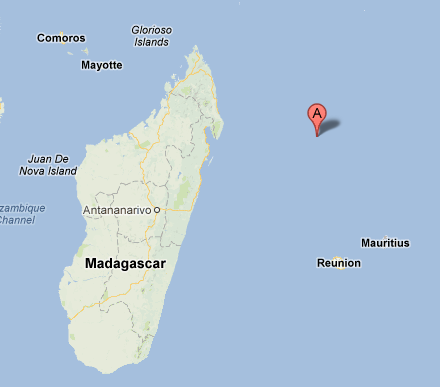The Slaves of Tromelin Island

Tromelin Island is a small dot of land — about a third of a square mile, or .8 square kilometers — situated about 220 miles east of Madagascar. (It’s where the red flagged “A” is in the map above.) It is mostly sand; its original name was Ile de Sables, or “island of sand.” It is administered by the French government and claimed by the French as their territory, although both Madagascar and the Seychelles also lay claim to it. No one lives on the island, and getting there is tricky — it is surrounded by coral reefs, making it difficult at best for ships to drop anchor there. Which is a lesson that a slave ship, back in 1761, learned the hard way.
That year, a French ship, the Utine, travelled from Mauritius toward Madagascar, carrying a few dozen sailors and in excess of 150 slaves. But the Utine ran into the reefs and began to take on water. An untold number of sailors and slaves, believed to be nearly 100, went down with the ship. But an estimated sixty slaves and a handful of the ship’s crew made it ashore to the flat, sandy beach later named Tromelin Island. The crewmen fashioned a raft out of the wrecked ship and sailed back toward Mauritius. They promised to return to rescue the five dozen slaves they left behind, but when they arrived, safely, the officials on Mauritius refused to send out a rescue party — saving slaves wasn’t deemed to be worth the risk. The sixty or so slaves were left behind to die.
Most of them did. Not all, however. According to the Independent, the group of slaves subsisted on a diet of birds, turtles, and shellfish. They built a communal oven, repaired copper utensils, and used the coral to create shelters. They — or perhaps the sailors –started a fire from the wood from the wreckage; regardless, the slaves kept that fire burning until help arrived. And help did, in fact, arrive — in 1776. Fifteen years after the Utine crashed down off the shore of this isle of sand, a French warship arrived on the island to find seven women and one eight-month-old baby alive, barely, living there. The captain, surnamed Tromelin, brought these eight people back to Mauritius, and was honored by having the island named after him.
The fate of the slaves was lost to time, but we know that they gained their freedom upon their arrival at Mauritius. The new governor there noted that the slaves on the Utine were purchased illegally and, therefore, were to be set free.
Bonus fact: Slavery is now illegal throughout the world. In 1981, Mauritania (not Mauritius) became the last country to ban the practice. (And until 2007, one could own a slave there without facing criminal penalties; now, the penalty for enslaving someone is up to 10 years in prison.) Per one estimate from 2004, there are as many as 24 million slaves in the world, more than any other time in human history.
From the Archives: Free Shipping: The slave who mailed himself to freedom.
Related: A sea turtle night light. Barely related, admittedly, but I own multiple of these. (Really. They’re great.)

Leave a comment